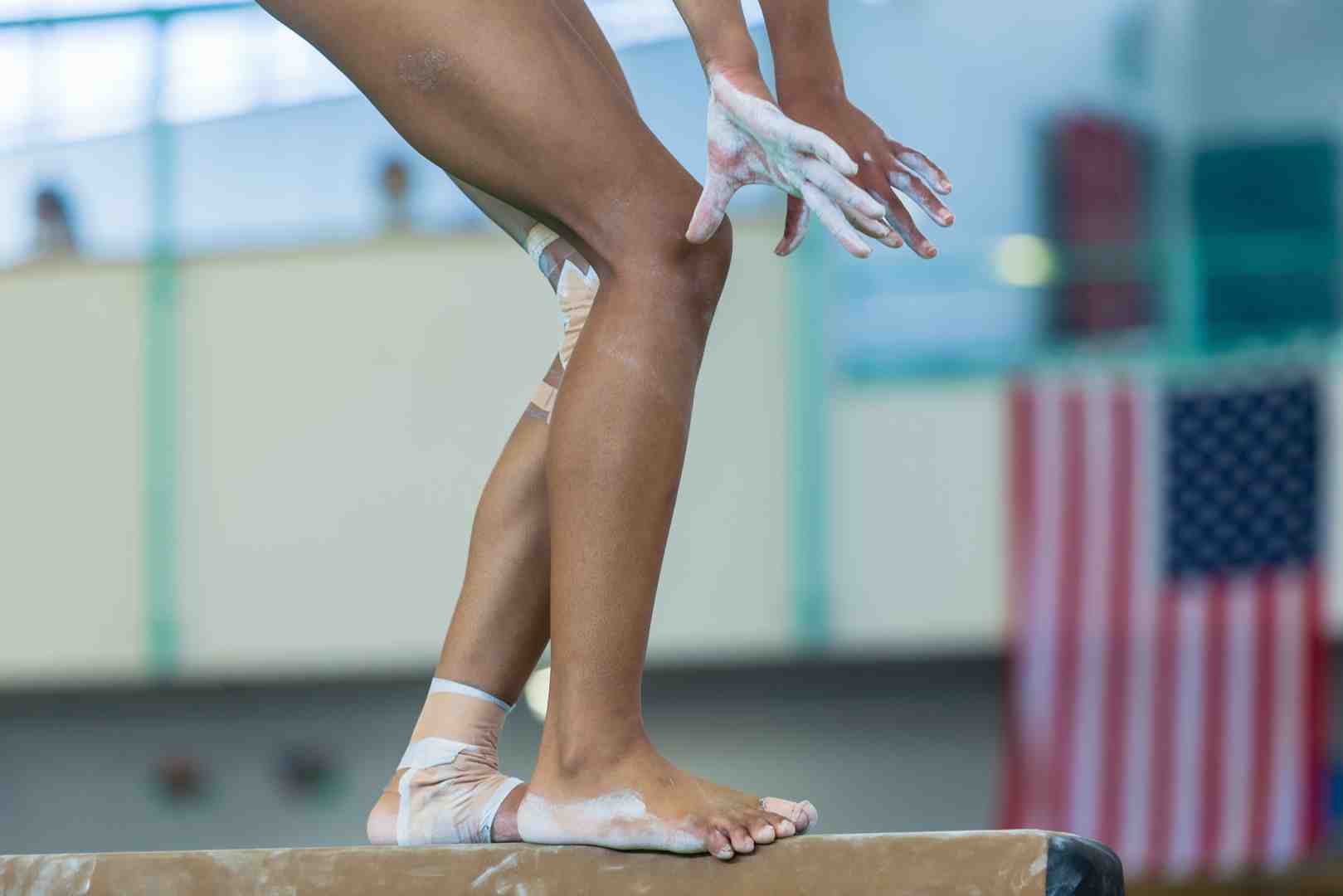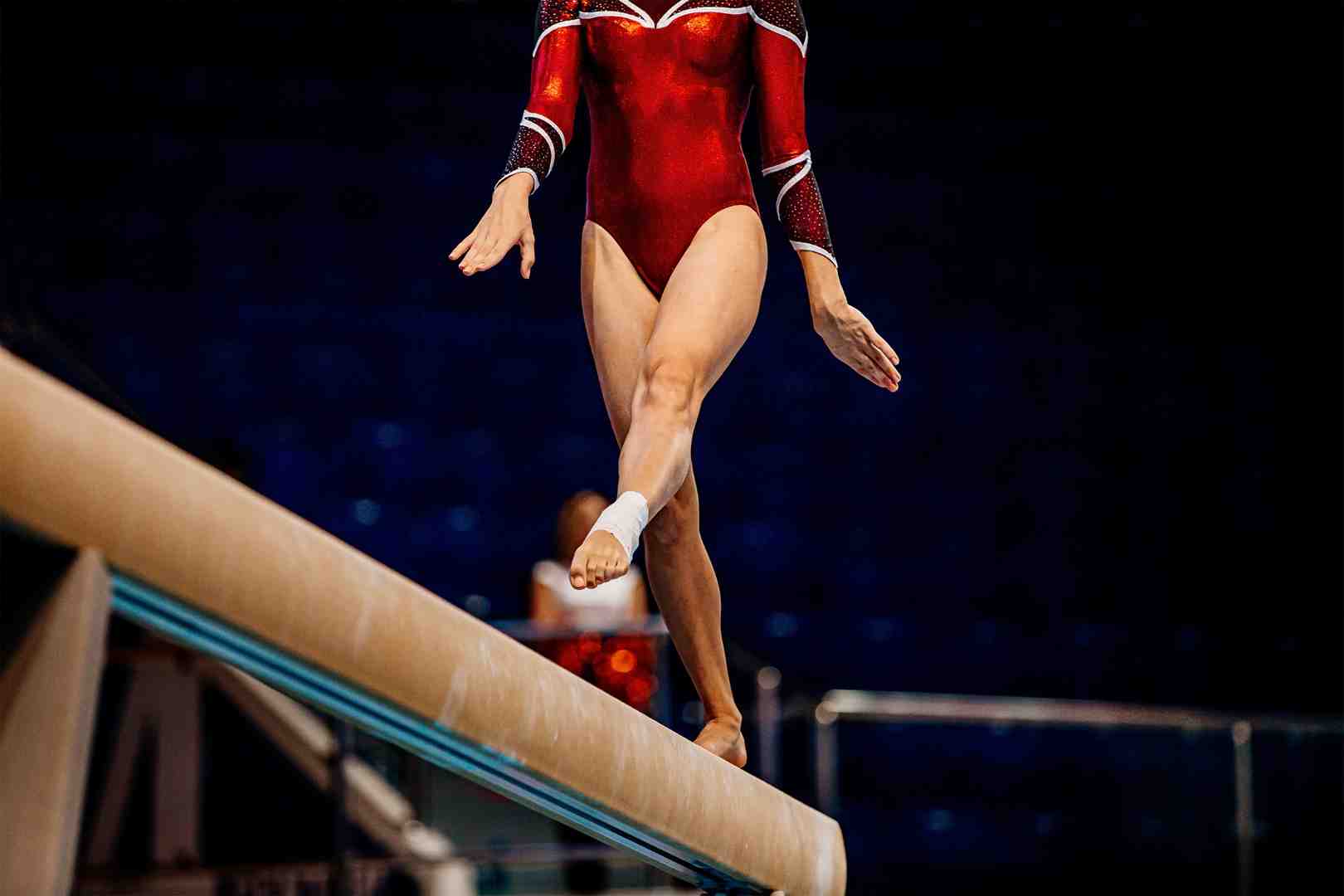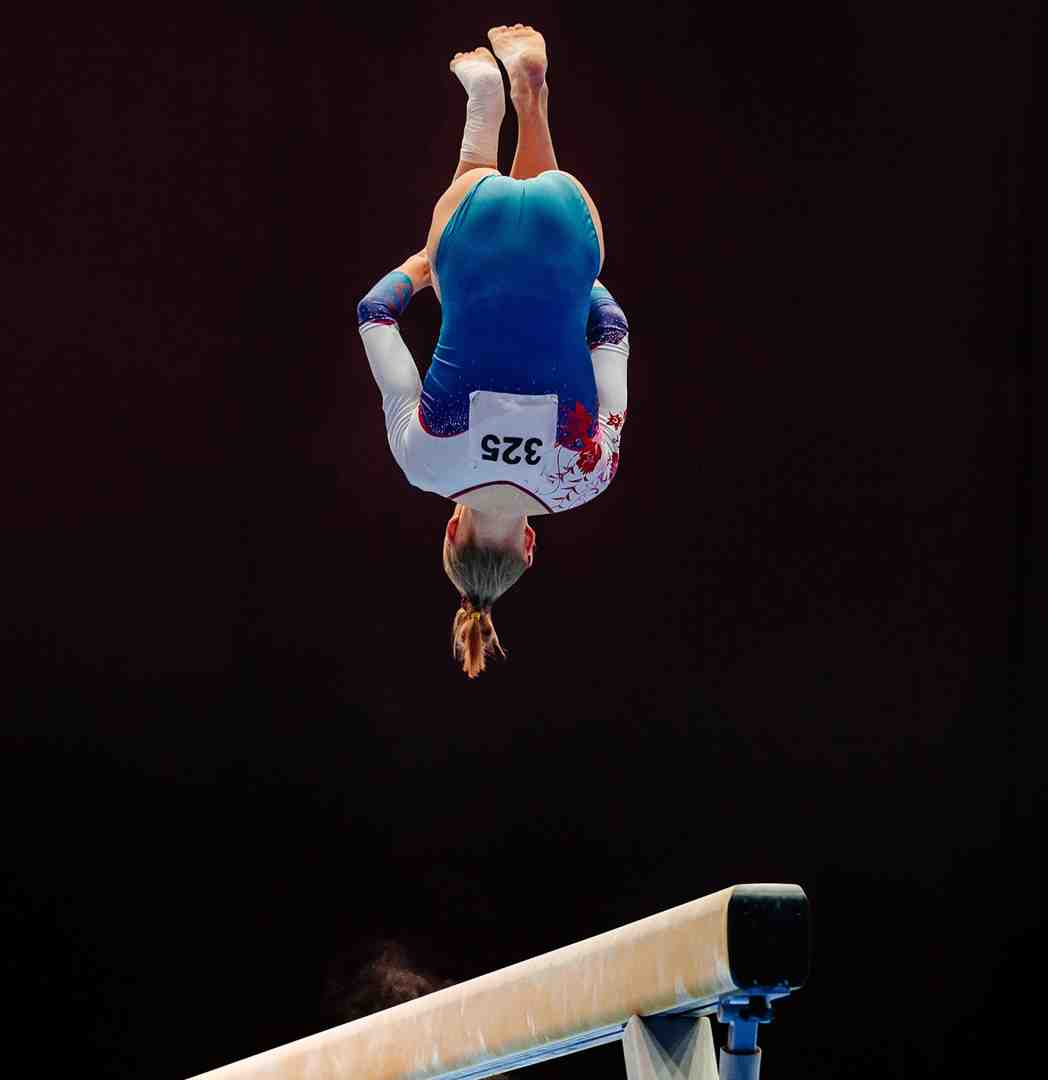Flip Without Fear – Your Guide to Athletic Tape for Gymnastics
Why Athletic Tape is Essential for Gymnastics Success

Athletic tape for gymnastics provides crucial protection and support that allows gymnasts to train and compete with confidence. Whether you're preventing painful rips on the bars, stabilizing wrists during tumbling passes, or protecting fingers during ring work, the right tape can make the difference between a successful routine and a sidelined athlete.
Key Benefits of Athletic Tape for Gymnastics:
- Injury Prevention - Protects against common gymnastics injuries like sprains and tendon stress
- Skin Protection - Prevents painful rips and calluses on hands and fingers
- Joint Stability - Provides support during high-impact landings and dynamic movements
- Improved Grip - Improves bar contact and reduces slipping during routines
- Pain Relief - Supports overused muscles and joints during training
The gymnastics community has accepted athletic tape as an essential tool. Research shows that over 10,000 packs of athletic tape are purchased monthly on Amazon alone, with many specifically chosen by gymnasts seeking reliable hand and joint protection.
From economy rolls for daily training to premium zinc oxide tape, stretch tapes, and kinesiology tapes used to perform and protect during competition, understanding your options helps you make smart choices. Pre-wrap foam prevents skin irritation, while specialized finger tape offers targeted protection for bar work.
Safety comes first - proper application technique and quality materials prevent circulation issues and skin damage that can sideline your training. Performance follows when you have the confidence to attempt new skills without fear of injury.
I'm Josh Key, part of the team at SHIELD Health and Fitness, and we are both a tape manufacturer (made in USA), and a group who works with athletes to test and develop athletic tape for gymnastics with everyone from weekend warriors to elite competitors.

Why Gymnasts Use Athletic Tape
If you've ever watched gymnastics training, you've probably noticed athletes with white tape wrapped around their wrists, fingers, and ankles. This isn't just a fashion statement - it's a crucial part of staying healthy in one of the most demanding sports on earth.
Gymnastics puts incredible stress on the human body. Gymnasts flip through the air, land with forces several times their body weight, and grip bars so hard their hands literally tear. The repetitive nature of training means these stresses happen hundreds of times per week.
Athletic tape for gymnastics has become essential because it addresses the unique challenges gymnasts face. Hand rips alone cause more missed training days than almost any other gymnastics injury.
Here's why gymnasts reach for their tape bag before every training session:
Injury prevention tops the list. The explosive movements and repetitive stress of gymnastics create perfect conditions for overuse injuries. Good tape provides external support that helps joints and muscles handle these demands.
Skin protection goes deeper than preventing rips. Quality tape creates a barrier that lets gymnasts grip bars confidently without worrying about tearing their hands open. This psychological benefit is huge - fear of pain can hold back skill development.
Joint stability becomes critical during dynamic skills. When you're flipping backwards on a 4-inch beam, your ankles and wrists need all the support they can get. Tape provides proprioceptive feedback that helps athletes land more safely.
Building confidence might be tape's most important benefit. Knowing you're protected allows gymnasts to push boundaries and attempt new skills without fear holding them back.
What Is Athletic Tape & How It Works
Athletic tape for gymnastics isn't just any sticky material - it's specifically engineered for athletic performance. The foundation is typically a cotton or cotton-blend weave that provides strength while allowing the tape to breathe.
The magic happens in the adhesive. Most quality tapes use zinc oxide adhesive, which creates a strong bond with skin without causing irritation. This medical-grade adhesive is designed to stick through sweat and movement while peeling off cleanly when you're done.
The cotton weave construction gives the tape its distinctive hand-tearable quality - no scissors needed during quick training applications. The weave also allows air circulation, preventing the soggy, uncomfortable feeling that comes with non-breathable materials.
When applied correctly, tape works by providing external mechanical support to soft tissues. It's like having an extra ligament that limits dangerous movements while allowing normal function.
How Athletic Tape Helps Prevent Common Gymnastics Injuries
Hand rips are probably the most feared gymnastics injury. Scientific research on hand skin tears shows that friction from bar work creates incredible stress on palm and finger skin. Quality tape distributes these forces across a larger area, preventing the concentrated pressure that causes rips.
Wrist sprains happen when tumbling and vaulting forces exceed what joints can handle. Proper wrist taping provides compression and limits the excessive extension that damages ligaments.
Tendon stress builds up from repetitive movements, especially in wrists, fingers, and ankles. Supportive taping reduces mechanical stress on these structures during training, giving them a chance to recover between sessions.
Blisters are common issues given the friction of gymnastics movements, and despite seeming like nuisances, can really take you out of the game if they progress to open wound injuries. Taping areas of known blister risk can prevent this, keeping athletes in play.
Ankle sprains are a common reality of gymnastics, and they can range from severe to light severity. In some cases, supportive taping with stretch tapes and wraps can help keep athletes performing through prevention, or can allow safe training following a sprain, during rehabilitation guided by a trainer.
The key insight is that tape works best as prevention, not treatment. Once an injury occurs, proper medical evaluation takes priority over any taping technique.
Types of Athletic Tape for Gymnastics – Finding Your Perfect Match
Walking into a sports store and seeing rows of different tapes can feel overwhelming. Which athletic tape for gymnastics will actually help your training? Once you understand what each type does best, choosing becomes much simpler.

Pre-Wrap & Foam Underwrap
Pre-wrap isn't actually tape - it's a thin foam layer that goes under your real tape. Think of it as the sock you wear inside your shoe.
This foam underwrap reduces chafing by creating a smooth barrier between your skin and the adhesive tape. It's surprisingly breathable and makes quick application possible during training adjustments.
The standard size is 2.75 inches wide by 30 yards long, which gives you plenty to work with.
Classic Trainer's Tape
When gymnasts talk about "athletic tape," they usually mean classic trainer's tape. This athletic tape for gymnastics provides high support with minimal stretch.
Trainer's tape is all about rigid support. When you need to limit movement in a specific direction - like preventing your wrist from bending too far back during a handstand - this tape gets the job done.
The limited stretch is actually trainer's tape's superpower. Elastic tapes can stretch out and lose effectiveness. Trainer's tape maintains the same level of support from the first tumbling pass to the last dismount.
Quality trainer's tape tears by hand cleanly and easily. No scissors needed, no jagged edges. The most common size is 1.5 inches wide, which works well for wrists, fingers, and most gymnastics applications. Some tapes come in high-tack adhesive formulas, supporting a really robust grip and stick.
Stretch Tape, Kinesiology Tape: Range of Motion, Compression, Dynamics
Stretch tapes and Kinesiology tape works completely differently from traditional trainer's tape. Instead of restricting movement, it's designed to support your body's natural motion patterns. These tapes allow range of motion while still providing compression, support, and bio-feedback that helps athletes train with confidence.
The category of stretch elastic tapes usually stretch up to 100% of their original length, which means it moves with you through even the most complex skills. At the same time, these tapes can wrap ankles and wrists like traditional cotton training tape, providing compression and support. This makes it popular for gymnasts who want support without feeling restricted. SHIELD Reflex is an example of these tapes - they tear by hand, have a moderate stick for single-day use, and are low profile.
Kinesiology tapes are different in a few ways. They are often only cut with scissors, have a longer-term wear and a more aggressive adhesive stick, and can stretch beyond 100% (sometimes up to or over 200%). With tehse tapes, you can shower, swim, and sweat through multiple training sessions while the tape stays put. Some applications can last 3-7 days with proper care. Rather than wrapping like a traditional tape, Kineioslogy tapes (Like SHIELD Apex) are tapes around joints and muscles to provide biofeedback and support without compression or restraint of those joints.
Finger & Thumb Tape for Bar Skills
Bar work is tough on hands, and regular athletic tape can be too bulky for precise finger protection. Specialized finger and thumb tapes, usually 0.5 to 1 inch wide, provide targeted protection exactly where you need it.
Hook grip protection is crucial for gymnasts who do a lot of bar work. Zero residue adhesives are essential - regular tape can leave sticky residue that makes gripping harder. Micro-width options let you tape individual fingers precisely without creating bulk.
How to Apply Athletic Tape for Gymnastics (Step-by-Step)
Learning proper application technique transforms athletic tape for gymnastics from a simple bandage into a performance tool. Taking a few extra minutes to apply tape correctly saves time later and prevents the frustration of mid-routine failures.

Wrist Support That Won't Slip
Your wrists take tremendous force during tumbling passes and vault landings. Proper wrist taping provides crucial support without limiting the flexibility you need for skills.
Start with pre-wrap around the entire wrist area, overlapping each layer by half the tape width. This creates a smooth foundation that prevents the adhesive tape from sticking directly to your skin and hair.
The spiral method works best for wrist support. Begin your first anchor strip about two inches below the wrist joint, wrapping completely around your forearm. Spiral upward with consistent tension, maintaining that 50% overlap with each wrap. The tension should feel snug but not tight.
Finish with a second anchor strip that wraps completely around your forearm above the wrist. Always perform a flex test before returning to training. Make a fist, flex your wrist up and down, and rotate it gently. You should feel supported but not restricted.
Finger & Thumb Protection for Bar & Ring Work
Bar work creates unique friction challenges that require targeted protection. The goal is preventing rips and blisters without adding bulk that interferes with your grip.
For individual finger protection, cut your tape into strips about three to four inches long. The X-wrap technique provides excellent protection - start at the base of your finger, cross over the knuckle, and anchor the tape in your palm.
Thumb protection requires a different approach. Start at your wrist with a six-inch strip, wrap around the thumb base, cross your palm, and return to the wrist. Add a second strip perpendicular to the first for maximum stability.
The buddy-strap method works well for fingers that need extra support. Tape an injured or vulnerable finger to an adjacent healthy finger, creating mutual support during bar work.
Ankle & Achilles Safeguard During Beam & Vault
Ankle injuries can sideline gymnasts for weeks, making prevention through proper taping essential. Start with pre-wrap from mid-calf to mid-foot, creating a smooth foundation.
The stirrup-wrap technique provides excellent ankle stability. Create stirrup strips that run from the inside of your calf, under your foot, and up to the outside of your calf. These strips prevent the dangerous inward rolling motion that causes most ankle sprains.
Add horizontal anchor strips above and below the ankle joint to lock your stirrups in place. Finish with a heel-lock pattern for maximum stability. This figure-eight pattern around your heel and ankle provides support in multiple directions while maintaining flexibility.
Always perform a tension check after application. You should be able to point and flex your foot through normal range of motion without restriction.
Choosing, Storing & Removing Tape Like a Pro
Smart tape selection and care practices maximize your investment while protecting your skin and performance.

Features to Look For When Buying Athletic Tape for Gymnastics
Several key features separate professional-grade athletic tape for gymnastics from basic medical tape that won't hold up to intense training.
Tearability should be your first test. Quality tape tears cleanly by hand without scissors, creating smooth edges that won't catch on equipment or fray during use.
The cotton blend and other premium fabrics can make the difference for skin and comfort. Pure cotton or cotton-blend materials breathe naturally, preventing the moisture buildup that can lead to skin irritation and rashes. For kinesiology tapes, high-end elastic fabrics should feel smooth to the touch and should allow free movement without constriction.
Water resistance doesn't mean waterproof, but good tape maintains its grip through sweat and brief water exposure. This becomes crucial when you're training multiple sessions per day.
Color coding as an organizational tool helps you grab the right roll quickly when you're rushing between events.
Safe Removal & Skin Care
Proper removal technique protects your investment in healthy skin that can handle daily taping.
The soak method takes patience but saves your skin. Apply warm water, lotion, or petroleum gel to soften the adhesive completely. When you start peeling, work in the direction of hair growth using steady, slow tension.
Post-removal care often gets skipped, but it's helpful for athletes who tape regularly. Clean the skin with mild soap to remove adhesive residue. Follow up with moisturizer to prevent dryness and cracking.
Commercial adhesive removers work faster than soap and water, but test on a small skin area first. Watch for signs of rash or irritation that suggest you need to switch tape types or take a break from taping.
Storage & FSA/HSA Tips
Proper storage directly affects how your tape performs when you need it most. Store your tape in a cool, dry location away from direct sunlight. Keep original packaging or transfer rolls to sealed containers immediately.
Here's something many athletes don't know - athletic tape qualifies for FSA and HSA reimbursement when used for injury prevention or treatment. Keep your receipts and check with your plan administrator about specific requirements.
Budget planning becomes easier when you calculate monthly usage and buy in bulk during sales. Quality tape costs more upfront but provides better value through improved durability and fewer application failures.
Frequently Asked Questions about Athletic Tape & Gymnastics
How long will one roll last in daily training?
For light training - maybe 2-3 sessions per week - one standard 1.5" x 15-yard roll typically lasts about 2-3 weeks. If you're doing moderate training with 4-5 sessions weekly, that same roll will probably last you 1-2 weeks. Intensive training with 6+ sessions per week might require 2-3 rolls weekly.
The sweat factor plays a bigger role than most people realize. When you're training in hot, humid conditions, the adhesive just doesn't last as long, requiring 25-50% more tape than athletes training in climate-controlled gyms.
Can the same tape be used for other sports?
Absolutely! Quality athletic tape for gymnastics is incredibly versatile.
Cross-training activities like weightlifting, rock climbing, and functional fitness all use the same basic taping principles. Those wrist wraps you learned for vault work are perfect for heavy deadlifts too.
Team sport athletes regularly borrow gymnastics taping techniques. Soccer players use identical ankle taping methods, basketball players tape their wrists the same way, and volleyball players often copy our finger protection strategies.
Are there any downsides to over-taping?
Yes, and this is something we take seriously.
Circulation problems are the most immediate concern. Taping too tightly or leaving tape on for too long can restrict blood flow, causing numbness, tingling, or tissue damage.
Psychological dependency is subtler but equally problematic. Some athletes become so reliant on tape that they feel unable to train without it, even when the original injury has resolved. As much as a tape manufacturer such as ourselves would like to sell more tape, it's important to know that we see our product as a temporary solution or a performance support, not a necessary tool to be used all the time, forever. Especially when recovering from an injury, taping should be a temporary support system!
Skin irritation becomes a real issue with constant use. Contact dermatitis, allergic reactions, and skin breakdown from trapped moisture can sideline you faster than the original problem.
Our philosophy is strategic taping - use it when you need it, for specific purposes, rather than as a security blanket for every training activity.
Conclusion
You've made it through the complete guide to athletic tape for gymnastics - and that's already a win. Most athletes skip the preparation and jump straight into training, but you understand that the best gymnasts aren't just the most talented ones; they're the smartest about protecting themselves.
Every piece of tape you apply correctly is like making a small deposit in your gymnastics bank account. Those deposits add up to fewer missed training days, more consistent skill development, and the confidence to attempt new moves without fear.
The foundation starts with smart choices. Rigid trainer's tape when you need rock-solid joint support. Kinesiology tape when you want to move freely while getting gentle assistance. Specialized finger tape when bar work threatens to tear up your hands.
Technique beats expensive products every single time. Master the basics - proper pre-wrap application, the spiral method for wrists, the stirrup technique for ankles. Practice these until they become as automatic as chalking your hands.
At SHIELD Health & Fitness, we've spent years watching athletes find what works. Our American-made tapes earn trust from professional teams because we understand that when you're upside down on a high bar or sticking a difficult landing, quality isn't negotiable.
Your gymnastics journey should be about joy, not fear. Fear of rips that end your training session early. Fear of ankle rolls that sideline you for weeks. Fear of wrist pain that makes you hesitate on skills you've done a thousand times before.
The right athletic tape for gymnastics removes those fears and replaces them with confidence. Confidence to grab the bar harder. Confidence to stick that landing. Confidence to push your limits because you know you've prepared properly.
Every great gymnast has a toolkit of habits that separate them from everyone else. Smart taping deserves a place in that toolkit, right alongside proper warm-up, consistent practice, and mental preparation.
Ready to make athletic tape for gymnastics part of your success story? More info about our Pro Tapes and find why athletes who demand the best choose American-made quality for their most important training sessions.
Your next breakthrough routine is waiting. Make sure you're properly protected when it happens.

